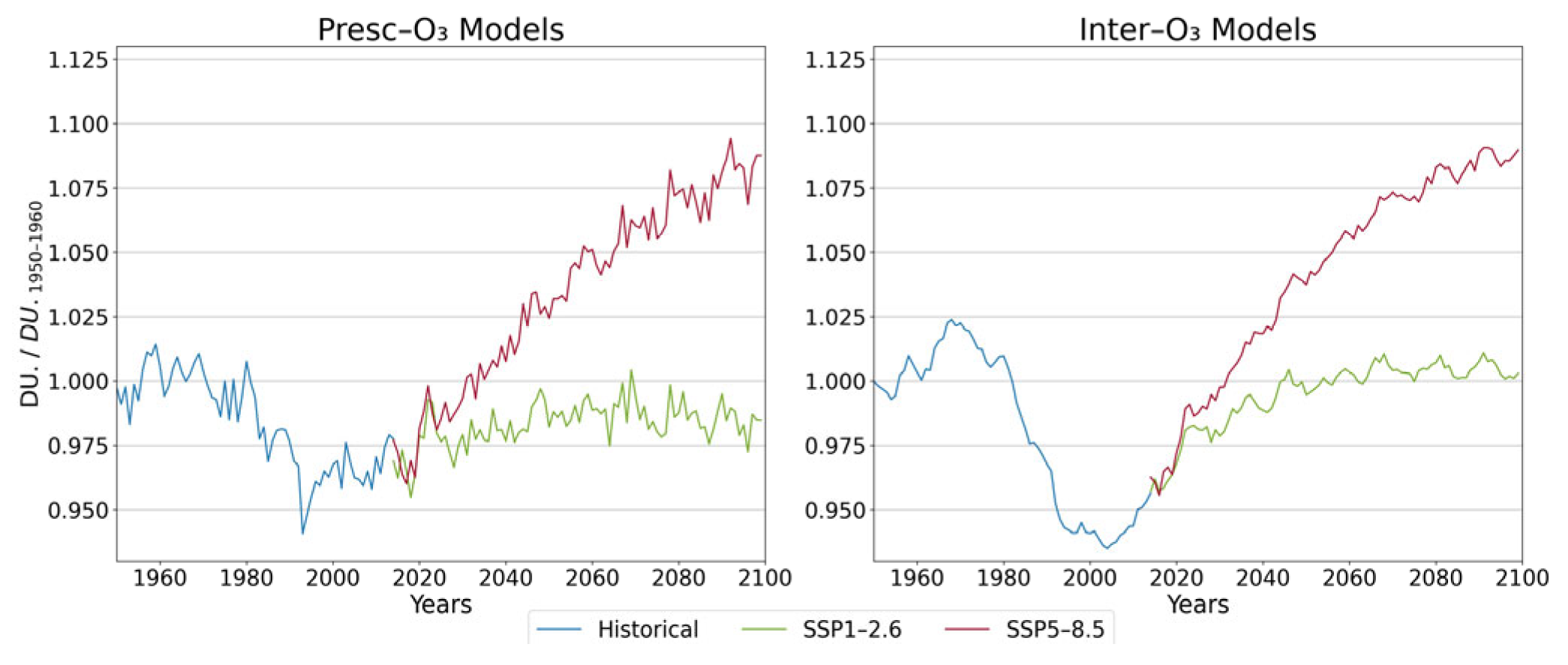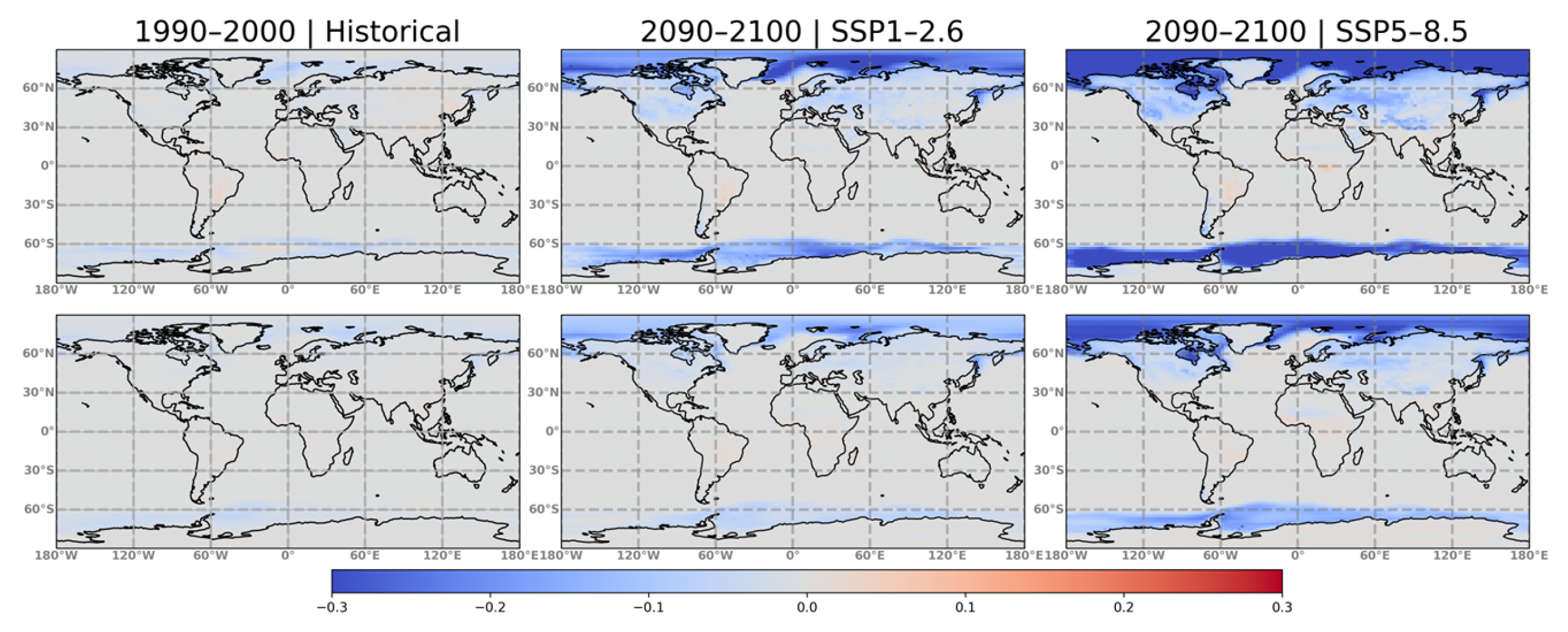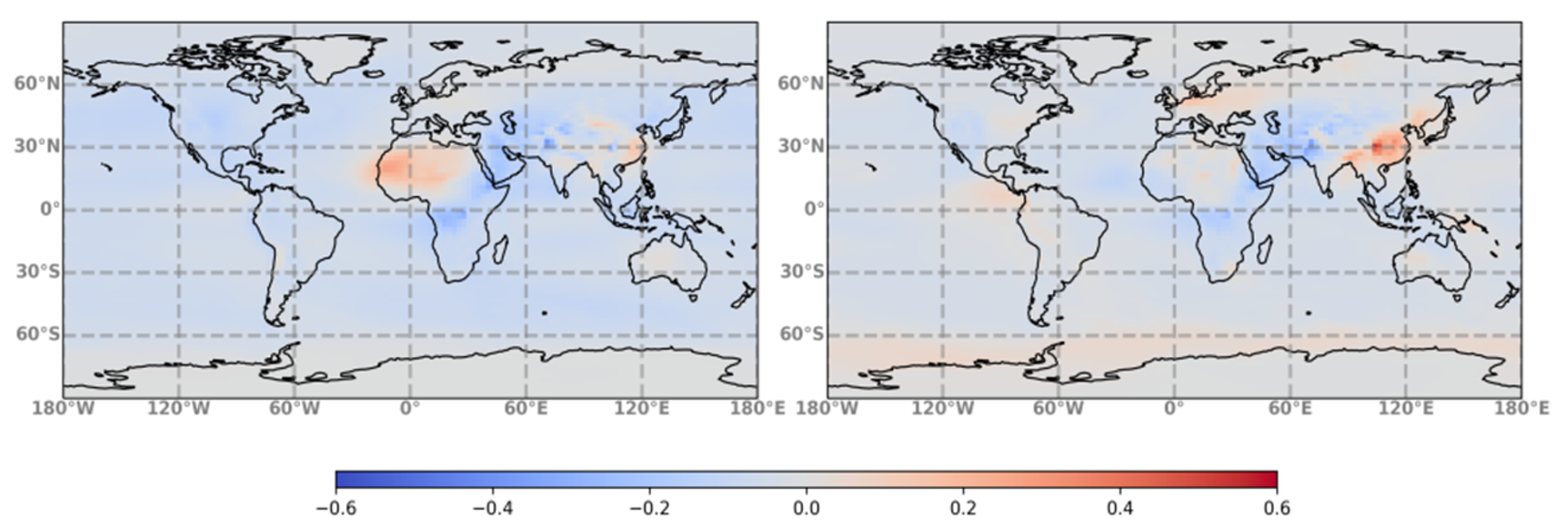An Assessment of the Relative Importance of Factors Impacting Surface UV Radiation Based on Simulations of the 6th Phase of the Coupled Intercomparison Project †
Abstract
:1. Introduction
2. Materials and Methods
3. Results
4. Conclusions
Author Contributions
Funding
Data Availability Statement
Conflicts of Interest
References
- Barnes, P.W.; Williamson, C.E.; Lucas, R.M.; Robinson, S.A.; Madronich, S.; Paul, N.D.; Bornman, J.F.; Bais, A.F.; Sulzberger, B.; Wilson, S.R.; et al. Ozone depletion, ultraviolet radiation, climate change and prospects for a sustainable future. Nat. Sustain. 2019, 2, 569–579. [Google Scholar] [CrossRef]
- Barnes, P.W.; Robson, T.M.; Neale, P.J.; Williamson, C.E.; Zepp, R.G.; Madronich, S.; Wilson, S.R.; Andrady, A.L.; Heikkilä, A.M.; Bernhard, G.H.; et al. Environmental effects of stratospheric ozone depletion, UV radiation, and interactions with climate change: UNEP Environmental Effects Assessment Panel, Update 2021. Photochem. Photobiol. Sci. 2022, 21, 275–301. [Google Scholar] [CrossRef] [PubMed]
- Hunter, N.; Rendell, R.J.; Higlett, M.P.; O’Hagan, J.B.; Haylock, R.G.E. Relationship between erythema effective UV radiant exposure, total ozone, cloud cover and aerosols in southern England, UK. Atmos. Chem. Phys. 2019, 19, 683–699. [Google Scholar] [CrossRef]
- Tourpali, K.; Bais, A.F.; Kazantzidis, A.; Zerefos, C.S.; Akiyoshi, H.; Austin, J.; Brühl, C.; Butchart, N.; Chipperfield, M.P.; Dameris, M.; et al. Clear sky UV simulations for the 21st century based on ozone and temperature projections from Chemistry-Climate Models. Atmos. Chem. Phys. 2009, 9, 1165–1172. [Google Scholar] [CrossRef]
- Waugh, D.W.; Oman, L.D.; Kawa, S.R.; Stolarski, R.S.; Pawson, S.; Douglass, A.R.; Newman, P.; Nielsen, J. Impacts of climate change on stratospheric ozone recovery. Geophys. Res. Lett. 2009, 36. [Google Scholar] [CrossRef]
- EEAP. Environmental Effects and Interactions of Stratospheric Ozone Depletion, UV Radiation, and Climate Change; 2022 Assessment Report; Environmental Effects Assessment Panel, United Nations Environment Programme (UNEP): Nairobi, Kenya, 2023; Available online: https://ozone.unep.org/science/assessment/eeap (accessed on 1 June 2022).
- Prather, M.J.; Holmes, C.; Hsu, J. Reactive greenhouse gas scenarios: Systematic exploration of uncertainties and the role of atmospheric chemistry. Geophys. Res. Lett. 2012, 39. [Google Scholar] [CrossRef]
- McKenzie, R.B.; Björn, L.O.; Bais, A.F.; Ilyasd, M. Changes in biologically active ultraviolet radiation reaching the Earth’s surface. Photochem. Photobiol. Sci. 2003, 2, 5–15. [Google Scholar] [CrossRef]
- Kuniyal, J.C.; Guleria, R.P. The current state of aerosol-radiation interactions: A mini review. J. Aerosol Sci. 2019, 130, 45–54. [Google Scholar] [CrossRef]
- Boucher, O.; Randall, D.; Artaxo, P.; Bretherton, C.; Feingold, G.; Forster, P.; Kerminen, V.M.; Kondo, Y.; Liao, H.; Lohmann, U.; et al. 2013: Clouds and Aerosols. In Climate Change 2013: The Physical Science Basis. Contribution of Working Group I to the Fifth Assessment Report of the Intergovernmental Panel on Climate Change; Cambridge University Press: Cambridge, UK; New York, NY, USA, 2013. [Google Scholar]
- Chin, M.; Diehl, T.; Tan, Q.; Prospero, J.M.; Kahn, R.A.; Remer, L.A.; Yu, H.; Sayer, A.M.; Bian, H.; Geogdzhayev, I.V.; et al. Multi-decadal aerosol variations from 1980 to 2009: A perspective from observations and a global model. Atmos. Chem. Phys. 2014, 14, 3657–3690. [Google Scholar] [CrossRef]
- Lamarque, J.-F.; Bond, T.C.; Eyring, V.; Granier, C.; Heil, A.; Klimont, Z.; Lee, D.; Liousse, C.; Mieville, A.; Owen, B.; et al. Historical (1850–2000) gridded anthropogenic and biomass burning emissions of reactive gases and aerosols: Methodology and application. Atmos. Chem. Phys. 2010, 10, 7017–7039. [Google Scholar] [CrossRef]
- Riahi, K.; Van Vuuren, D.P.; Kriegler, E.; Edmonds, J.; O’Neill, B.C.; Fujimori, S.; Bauer, N.; Calvin, K.; Dellink, R.; Fricko, O.; et al. The Shared Socioeconomic Pathways and their energy, land use, and greenhouse gas emissions implications: An overview. Glob. Environ. Change 2016, 42, 153–168. [Google Scholar] [CrossRef]





| Inter-O3 Models | Presc-O3 Models | |||||||||||
|---|---|---|---|---|---|---|---|---|---|---|---|---|
| Hist. | SSP1–2.6 | SSP5–8.5 | Hist. | SSP1–2.6 | SSP5–8.5 | |||||||
| Jan | Jul | Jan | Jul | Jan | Jul | Jan | Jul | Jan | Jul | Jan | Jul | |
| 60–90° N | 0.0 ± 1.7 | −0.5 ± 0.8 | −2.8 ± 4.5 | −2.7 ± 5.2 | −9.8 ± 8.7 | −8.1 ± 12.4 | 0.5 ± 16.1 | −0.9 ± 1.4 | −5.2 ± 7.9 | −4.5 ± 5.6 | −16.3 ± 11.2 | −8.23 ± 12.8 |
| 30–60° N | 0.08 ± 1.0 | −0.13 ± 0.8 | 0.5 ± 3.7 | 2.05 ± 1.9 | −0.73 ± 7.7 | 3.15 ± 3.8 | 0.0 ± 1.1 | 0.28 ± 0.9 | −2.0 ± 4.0 | 1.36 ± 1.8 | −4.0 ± 10.0 | 4.31 ± 5.5 |
| 30° N–30° S | −0.17 ± 0.8 | −0.17 ± 0.6 | 0.41 ± 1.5 | 0.44 ± 1.5 | 0.88 ± 2.9 | 1.06 ± 3.1 | 0.0 ± 0.6 | 0.08 ± 0.6 | 0.08 ± 1.5 | 0.02 ± 1.5 | 0.19 ± 4.0 | −0.03 ± 4.4 |
| 30–60° S | 0.06 ± 1.0 | 0.3 ± 0.9 | 0.47 ± 1.4 | 0.94 ± 1.9 | 0.23 ± 3.7 | 1.49 ± 4.1 | 0.46 ± 1.1 | 0.33 ± 1.0 | −0.23 ± 1.9 | −0.19 ± 2.3 | −0.63 ± 4.8 | −0.7 ± 6.2 |
| 60–90° S | 0.01 ± 1.1 | −0.23 ± 1.9 | −1.79 ± 1.6 | −4.28 ± 4.1 | −5.1 ± 3.3 | −11.5 ± 7.6 | −0.07 ± 1.0 | −0.42 ± 1.6 | −1.85 ± 1.8 | −3.13 ± 2.6 | −6.22 ± 5.1 | −10.6 ± 5.4 |
Disclaimer/Publisher’s Note: The statements, opinions and data contained in all publications are solely those of the individual author(s) and contributor(s) and not of MDPI and/or the editor(s). MDPI and/or the editor(s) disclaim responsibility for any injury to people or property resulting from any ideas, methods, instructions or products referred to in the content. |
© 2023 by the authors. Licensee MDPI, Basel, Switzerland. This article is an open access article distributed under the terms and conditions of the Creative Commons Attribution (CC BY) license (https://creativecommons.org/licenses/by/4.0/).
Share and Cite
Chatzopoulou, A.; Tourpali, K.; Bais, A.F.; Braesicke, P.; Ruhnke, R. An Assessment of the Relative Importance of Factors Impacting Surface UV Radiation Based on Simulations of the 6th Phase of the Coupled Intercomparison Project. Environ. Sci. Proc. 2023, 26, 119. https://doi.org/10.3390/environsciproc2023026119
Chatzopoulou A, Tourpali K, Bais AF, Braesicke P, Ruhnke R. An Assessment of the Relative Importance of Factors Impacting Surface UV Radiation Based on Simulations of the 6th Phase of the Coupled Intercomparison Project. Environmental Sciences Proceedings. 2023; 26(1):119. https://doi.org/10.3390/environsciproc2023026119
Chicago/Turabian StyleChatzopoulou, Anthi, Kleareti Tourpali, Alkiviadis F. Bais, Peter Braesicke, and Roland Ruhnke. 2023. "An Assessment of the Relative Importance of Factors Impacting Surface UV Radiation Based on Simulations of the 6th Phase of the Coupled Intercomparison Project" Environmental Sciences Proceedings 26, no. 1: 119. https://doi.org/10.3390/environsciproc2023026119






